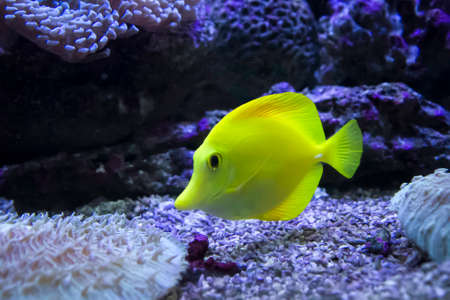1. Understand the Causes of Algae Growth
Algae growth is a common issue in aquariums, but understanding its causes can help you prevent and control it effectively. Several factors contribute to excessive algae growth, including excess nutrients, improper lighting, and poor water circulation.
Excess Nutrients
Algae thrive when there are too many nutrients in the water, primarily nitrates and phosphates. These nutrients come from fish waste, uneaten food, and decaying plant matter. If not managed properly, they create the perfect environment for algae to grow.
Common Sources of Excess Nutrients
| Source | Description |
|---|---|
| Fish Waste | Fish produce waste that breaks down into nitrates and phosphates. |
| Uneaten Food | Leftover food decomposes and releases nutrients into the water. |
| Decaying Plants | Dead or dying plants release nutrients as they break down. |
Lighting Issues
Too much light or improper lighting can also lead to excessive algae growth. Algae use light for photosynthesis, so keeping your aquarium lights on for too long or using high-intensity lighting can encourage rapid algae development.
Tips for Proper Lighting
- Avoid keeping aquarium lights on for more than 8-10 hours per day.
- Use a timer to maintain a consistent light schedule.
- Select appropriate lighting based on your tank’s needs (e.g., low-light plants require less intense lighting).
Poor Water Circulation
Stagnant water can create dead spots where debris accumulates, providing nutrients for algae. Proper water movement helps distribute oxygen and prevents nutrient buildup.
Ways to Improve Water Circulation
- Use a quality filter that suits your tank size.
- Add an air stone or powerhead to increase movement.
- Regularly clean filters to ensure efficient operation.
By understanding these factors, you can take proactive steps to reduce algae growth and maintain a cleaner, healthier aquarium environment.
2. Control Lighting Duration and Intensity
One of the key factors influencing algae growth in your aquarium is lighting. Too much light, or improper lighting schedules, can encourage excessive algae to develop. By adjusting the duration and intensity of your aquarium lighting, you can create a balanced environment that supports plant and fish health while minimizing algae growth.
Adjusting Your Lighting Schedule
In nature, aquatic plants and fish follow natural daylight cycles. To mimic this in your aquarium, its important to provide consistent lighting that doesn’t exceed recommended durations. Most freshwater aquariums do well with 8 to 10 hours of light per day.
| Aquarium Type | Recommended Lighting Duration |
|---|---|
| Planted Aquarium | 8-10 hours |
| Fish-Only Aquarium | 6-8 hours |
| High-Light Plants or Reef Tanks | 10-12 hours |
Using Timers for Consistency
A simple way to regulate your aquarium’s lighting schedule is by using an automatic timer. This ensures that lights turn on and off at the same time each day, preventing accidental overexposure that could lead to increased algae growth.
Avoiding Excessive Light Intensity
The intensity of your aquarium light also plays a role in algae control. If the light is too strong, it may encourage unwanted algae blooms. Consider using adjustable LED lights or choosing bulbs with appropriate brightness levels based on your tank size and inhabitants.
Tips for Managing Light Intensity:
- If you have live plants, choose a light spectrum suitable for plant growth but not overly bright.
- Avoid placing your aquarium in direct sunlight, as this can cause uncontrolled algae outbreaks.
- If algae problems persist, reduce the light intensity or shorten the duration slightly until balance is achieved.
By carefully managing both the duration and intensity of your aquarium lighting, you can create a healthier environment for your aquatic life while keeping algae under control.

3. Maintain Proper Water Quality
Keeping your aquarium water clean and balanced is one of the most effective ways to prevent algae growth. Algae thrive in environments with excess nutrients, poor filtration, and irregular maintenance. By following a few simple steps, you can maintain proper water quality and keep your tank looking its best.
Perform Regular Water Changes
One of the easiest ways to control algae is by changing your aquarium water on a regular basis. Water changes help remove excess nutrients that promote algae growth while also keeping your fish healthy.
Recommended Water Change Schedule
| Aquarium Size | Recommended Water Change Frequency | Percentage of Water to Change |
|---|---|---|
| Small Tanks (Under 20 Gallons) | Weekly | 25-30% |
| Medium Tanks (20-50 Gallons) | Every 1-2 Weeks | 20-25% |
| Large Tanks (Over 50 Gallons) | Every 2-4 Weeks | 15-20% |
Monitor Nutrient Levels
Nutrients like nitrates and phosphates contribute to excessive algae growth. Testing your water regularly will help you keep these levels under control.
Nutrient Level Guidelines
| Nutrient | Ideal Level | Avoid Above |
|---|---|---|
| Nitrate (NO3) | < 20 ppm | > 40 ppm |
| Phosphate (PO4) | < 0.1 ppm | > 0.5 ppm |
If nutrient levels are too high, consider reducing feeding amounts, using live plants to absorb excess nutrients, or adding chemical media designed to remove nitrates and phosphates.
Use a High-Quality Filtration System
A good filtration system is essential for keeping your aquarium water clear and free from debris. There are three main types of filtration that help maintain water quality:
Main Types of Filtration Systems
- Mechanical Filtration: Removes solid waste particles, uneaten food, and debris.
- Chemical Filtration: Uses activated carbon or other media to remove toxins and impurities.
- Biological Filtration: Supports beneficial bacteria that break down harmful ammonia and nitrites.
A well-maintained filter not only helps prevent algae but also ensures a healthier environment for your fish. Be sure to clean or replace filter media as needed to maintain efficiency.
4. Introduce Algae-Eating Fish and Invertebrates
One of the most natural and effective ways to control algae in your aquarium is by introducing algae-eating fish and invertebrates. These helpful creatures feed on different types of algae, keeping your tank clean while reducing the need for frequent manual cleaning.
Best Algae-Eating Fish
Several fish species are excellent at controlling algae growth. Here are some popular choices:
| Fish Species | Algae Type They Eat | Tank Requirements |
|---|---|---|
| Siamese Algae Eater | Hair algae, black beard algae | 30+ gallons, peaceful community tank |
| Bristlenose Pleco | Green spot algae, diatoms | 20+ gallons, needs hiding spots |
| Otocinclus Catfish | Diatoms, soft green algae | 10+ gallons, best in groups |
| Molly Fish | Softer green algae | 10+ gallons, adaptable to various water conditions |
Algae-Eating Invertebrates
If you want additional help with algae control, consider adding invertebrates like snails and shrimp. They are great at reaching areas that fish may not clean effectively.
| Invertebrate Species | Main Algae They Eat | Tank Requirements |
|---|---|---|
| Nerite Snail | Diatoms, green spot algae, soft film algae | No minimum size, but requires a lid (they climb out) |
| Amano Shrimp | Hair algae, leftover food debris | 10+ gallons, best in groups of 3 or more |
| Mystery Snail | Softer green algae, leftover food debris | No minimum size, requires calcium for shell health |
| Cherry Shrimp | Biofilm, soft green algae | No minimum size, thrives in planted tanks |
Tips for Keeping Algae-Eaters Healthy
- Avoid overstocking: Even though these creatures eat algae, they still produce waste that can contribute to poor water quality.
- Diversify their diet: Many algae-eating species also need supplemental food such as blanched vegetables or specialized pellets.
- Create a suitable environment: Ensure your tank provides hiding spots and stable water parameters for their well-being.
- Avoid harmful chemicals: Some medications and treatments can be toxic to invertebrates like snails and shrimp.
Addition of these natural helpers can significantly reduce unwanted algae growth while enhancing the beauty and balance of your aquarium ecosystem.
5. Use Chemical and Natural Algae Control Methods
Keeping algae under control in your aquarium requires a combination of methods, including chemical treatments and natural solutions. By using the right approach, you can maintain a clean and healthy tank for your fish and plants.
Chemical Algae Control
Chemical treatments can help eliminate algae quickly and effectively. However, they should be used with caution to avoid harming fish or beneficial bacteria in the tank.
Common Chemical Solutions
| Method | Description |
|---|---|
| Algaecides | Chemicals designed to kill algae; should be used sparingly to prevent harming fish. |
| CO2 Injection | Adds carbon dioxide to promote plant growth, which helps outcompete algae for nutrients. |
| Phosphate Removers | Reduces phosphate levels, limiting one of the main nutrients algae need to grow. |
Natural Algae Control
If you prefer a more eco-friendly approach, natural methods can help keep algae at bay while maintaining a balanced ecosystem.
Effective Natural Remedies
- Live Plants: Fast-growing aquatic plants absorb excess nutrients, making it harder for algae to thrive.
- Aquarium Clean-Up Crew: Snails, shrimp, and certain fish species feed on algae, helping control its spread.
- Proper Lighting: Reducing excessive light exposure prevents algae from growing too quickly.
- Regular Water Changes: Replacing 10-20% of the water weekly removes excess nutrients that fuel algae growth.
Combining Methods for Best Results
The best way to control algae is by using a mix of chemical and natural methods. If you rely solely on chemicals, you might disrupt the tank’s balance. On the other hand, only using natural remedies may not be enough if algae are already out of control. Finding the right balance will ensure a clean and thriving aquarium.

